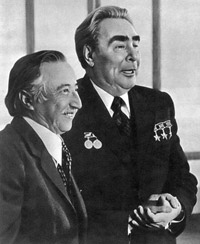Vladimir Musayelyan has been the personal photographer of the quietest and long life leader of USSR, Leonid Ilyich Brezhnev.
He was called the last photographer of the empire because he was not only updating the photo archives of Brezhnev but also was making the chronics of events taking place in socialistic states. Brezhnev’s governance period, during which there was no war, disaster, was called “glutted economy.” After USSR collapse everybody was trying to forget the times, when pathos and lie were mixed together and the boring life is now being replaced by the enlightened future. In 1970-1980 everything was predicted. They were saying no war and war wasn’t taking place.
After Brezhnev’s death many Russian and foreign newspapers were willing to buy photos from Musayelyan but he was giving a pathetic answer – “trust is not for sale.” He at the age of 28 has become the sole photographer of the General Secretary of the Communistic Party. Brezhnev was already 64. Prior to become a photographer Musayelyan was dreaming of aviation, worked at the factory as a carpenter and later has become an ITAR-TASS reporter.
“Photographing leaders is a heavy duty,” he confessed, who has always tried to make the pictures of the country’s leader as expressive as possible. Musayelyan didn’t try to degrade the reputation of the leader of the country by publishing humiliating pictures despite the fact that there were many of those. As it’s known Brezhnev used to like the active rest, medals, hunting and alcohol and at the last stage of his life he has turned into a stammering old man, who wasn’t even able to make decent speeches. There were many anecdotes about Brezhnev. However those “glutted years” still create certain nostalgia among people because at that time everybody was actually equal. Everything was planned and clear. Education, salaries, pensions, rest and leisure were guaranteed. Miserable but stable period! Of course those years were famous for heir dire deficit and unlimited censor but it was for everyone. Years later in 2006 the Russian History Museum organized an exhibition of the photographs of Vladimir Musayelyan, which was entitled “The General Secretary and his photographer” and was dedicated to the 100th anniversary of Brezhnev.
Brezhnev used to trust his photographer. He was feeling happy like a child when seeing his new pictures. He was saying, “this is a good picture, I look like Alen Delone here, etc.” Musayelyan has numerously mentioned in his interviews that Brezhnev was a sensitive person. Musayelyan has been next to Brezhnev for over 13 years, has escorted him during his traveling, and has photographed him in his rest, with the family and official meetings. Musayelyan has tried to show Brezhnev in different images, which would make his governance more lively and active – during hunting with a rifle, with the wife, grandchildren…
Musayelyan deserved the highest award for photographers – “Golden Eye” prize in the Netherlands annual World Press Photo competition. The winning photograph shows the leader of the Soviet Union at the moment when he’s crying. The tear was shining on Brezhnev’s cheek when he was speaking to the Communist Party leader of Chile, Louis Korvalan. Korvalan was sent to prison during Pinochet governance but in 1976 the USSR gave a political asylum to the Chilean communist leader. At that time Brezhnev wasn’t able to hide his excitement. However, later the tear on the picture was erased.
Armenian photographer, Vahan Kochar, who has recently released a wonderful complete piece dedicated to the activity of Armenian photographers, tells that the photograph, which was awarded the Golden Eye award, wasn’t accepted very well in the Soviet Union. Musayelyan’s photo was retouched and Brezhnev’s tear was erased from the image. And the photograph is famous without the tear. However it received an award because of the tear. Vahan Kochar is going to tell us about the fates of Armenian photographers in a separate book. This will enable the Armenian readers to remember the past and draw conclusions.

